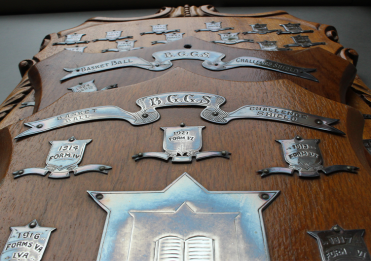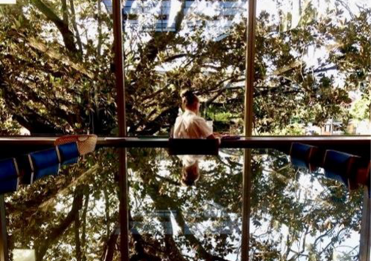In a meeting held in his chambers in July 1928, Chairman of the Board of Trustees, Mr Justice John Laskey Woolcock, made provision for two prizes to be distributed at Brisbane Girls Grammar School’s Annual Speech Day and Distribution of Prizes. One of these, the Betty Woolcock Challenge Cup, named in memory of one of Justice Woolcock’s daughters, was first presented that year.

The Betty Woolcock Challenge Cup
‘Betty’ Woolcock was born Dorothy Harpur Woolcock in May 1896 and was reported to be shy, sweet and loving with a gentle temperament. She was the second-born daughter of Mr Justice Woolcock and his first wife, Gertie Harpur. While Betty’s older sister, Margaret, attended Girls Grammar from 1905-1909, it seems Betty did not—though records are unclear.
In her mid-twenties, Betty married Ragnur Hyne—a Norway-born, Queensland-educated lawyer—and joined him in Tonga, where he served as Director of Education. Concerned about her potential loneliness, Justice Woolcock arranged for Betty’s cousin, Majorie Musman, to accompany her.

Family photo: Ragnur Hyne, Betty Hyne (nee Woolcock), her cousin Marjorie Musman. Moses and Davitah, servants, standing behind. Taken in Tonga, Friendly Islands. (Source: The Guiding Hand)
In May 1924, Betty and Ragnur returned to Brisbane for Betty to be the Matron of Honour at her brother, Leonard’s, wedding and to enjoy an extended holiday before departing for the Solomon Islands for Ragnur’s next assignment. Tragically, three weeks after the wedding, Betty, who was three months pregnant, fell ill from a sore lip and died of septicaemia and heart failure. She was buried the next day in the Woolcock family plot at Toowong Cemetery. Devastated by his daughter’s death, Justice Woolcock wrote the headstone inscription: ‘Memory is the best link between this world and a better’ (The Guiding Hand, p.152).

The Betty Woolcock Challenge Cup with bound 1920s School magazines.
In gifting Brisbane Girls Grammar School with the Betty Woolcock Challenge Cup, Mr Justice Woolcock united two things dear to him: his precious daughter; and his love of the English language. An alumni and former teacher at Brisbane Grammar School, Justice Woolcock maintained a lifelong connection with both Grammar schools, serving as Chairman of both Boards of Trustees from 1906 to 1929. A passionate writer and poet, Justice Woolcock won accolades for his literary talent during his university years in the 1880s, including a gold medal for English Verse and the Wentworth Gold Medal for English Essay. In a 1925 paper for the English and Modern Language Association of Queensland, he expressed his lifelong love of literature, emphasising the importance of clear language and the richness of the English language as a subject of study. He continued his literary pursuits even while serving as a judge on the Queensland Supreme Court.

Mr Justice John Laskey Woolcock
The minutes of the Board meeting in 1928 set out the original criteria for awarding the cup:
‘to be competed for annually by girls of the V and VI Form for the encouragement of original productions in the English language by means of an essay—a story or a poem. Subject to be chosen annually by the Head Mistress. The award to be made by the Head Mistress, Second Mistress, and Senior English Mistress—but in case of any difference arising, the choice to rest with the Head Mistress. Successful girl to be ineligible in future years. The successful production to be clearly copied and shared.’

The handwritten criteria for the Betty Woolcock Challenge Cup
Justice Woolcock’s Trust included a silver cup which was to be engraved with the winner’s name and presented at the Annual Speech Day and Prize Giving. Intermittently, awardees also received an engraved goblet as a personal keepsake.

The Betty Woolcock Challenge Cup, with the names of the first seven recipients.

Replica of The Betty Woolcock Challenge Cup, Erica Fryberg (1988) Courtesy: Erica Fryberg
The inaugural winner of the Betty Woolcock Challenge Cup was Fifth Form (Year 11) student, Kathleen Sully, who received the cup from Justice Woolcock at Speech Day. Kathleen’s untitled story of a haughty and greedy young prince—who inherits the kingdom from his much-loved father yet fails to heed his advice to rule with kindness and love—responded to a prompt from Genesis (49:26): ‘the blessings of thy father have prevailed unto the utmost bounds of the everlasting hills’. We don’t know who chose this prompt, but one wonders if it may have been Justice Woolcock himself—perhaps reflecting on his relationship with his daughter Betty and the blessings he wished to pass on to other aspiring young writers through this award.

Kathleen Sully (1929), first winner of The Betty Woolcock Challenge Cup, as a V Former.
Justice Woolcock died unexpectedly in February 1929. While he and Mrs Woolcock had presented Kathleen Sully with the Betty Woolcock Challenge Cup at Speech Day in 1928, he did not live to see the winning essay published and distributed as he had determined in the criteria. Kathleen Sully’s winning entry was published in the June 1929 School Magazine, the same edition that featured a moving tribute to the prize’s benefactor.

Story by Kathleen Sully (1929), the inaugural winner of the Betty Woolcock Challenge Cup. 1929 School Magazine pp6-7

Story by Kathleen Sully (1929), the inaugural winner of the Betty Woolcock Challenge Cup. 1929 School Magazine pp8-9
The winner of the Cup is recognised in several ways. In the 1928 Annual Report, Head Mistress, Miss Kathleen Lilley, notes:
‘The Betty Woolcock Challenge Cup, the gift of Mr Justice and Mrs Woolcock, in memory of the late Dorothy Harpur Hyne (Betty) and awarded for the encouragement or (sic) original production in the English language by means of an essay, was won this year by Kathleen Sully. We wish formally to express in this report our warmest appreciation and to convey our thanks to the donors of these two handsome cups.’
In the following early years, the Head Mistress named the winner in her Annual Report to the Board of Trustees. The Brisbane Courier occasionally reported on the prizegiving, and each year, the winner’s name is included in the Annual Report submitted to the Board of Trustees and tabled at the Queensland Legislative Assembly.

The winning entry published in the School Magazine.
Since 1928, the Cup has been awarded to 81 different girls, with five winning it twice despite the original rule that winners would be ineligible in the future. We don’t know why the prize was not awarded 11 times, but there has been a winner every year since 1972. Among the winners, 10 were awarded Dux of the School, and two of these—Caitlin Goss (2001) and Josephine Auer (2015)—were awarded Rhodes Scholarships. We have even had two pairs of sisters win the prize: Jacqueline Peel and Christine Peel in 1991 and 1992 respectively; and Kirsten Milligan (1975) and Catherine Milligan (1978). In 1960 and 2014, dual winners were announced.
The prize’s criteria have evolved to include responsiveness to a specific prompt, which was not originally required. While many of these prompts have been lost over time, some are occasionally included when the essay is published. Historically, prompts were sourced from poets like Blake, Brooke, Tennyson, Browning, and Eliot. However, since the late twentieth century, judges have predominantly used Shakespearean fragments—a tradition that continues to this day.
While there are no records of how each year’s winner was determined, it is presumed that the entries were initially reviewed by the Principal, and most likely English staff. From the early 21st century, the English Faculty has managed the prize, deciding on the prompt and inviting responses. An external adjudicator now judges the entries, providing detailed explanations for their decisions.
As Justice Woolcock laid out in the terms of the trust, the winning essay has been ‘shared’ with the Girls Grammar community through various forums. Due to end-of-year publishing deadlines, it was often included in the June edition of the School Magazine the following year. The single magazine, published annually since 1969, occasionally included the winning essay in the same year it was awarded, though this was not always guaranteed. There is no explanation for the absence of the essay from the magazine between 1974 and 1978. In the mid-1990s, original writing was featured in a separate publication called Imaginings, but the Betty Woolcock Challenge Cup winning essay returned to the school magazine until 2013. 2012 was the last year the winners entries were published in the Magazine—the committee must have decided there was insufficient space for original writing.

Imaginings 1993 Issue One and the Betty Woolcock Challenge Cup Entry by Johanna Sing.
Grammar girls have eagerly embraced this cup to showcase their diverse writing talents. Through essays, social commentary, short stories, and various forms of poetry, they have demonstrated their creative abilities and highlighted the beauty of language, fulfilling Justice Woolcock’s vision. While some of the writing styles might seem foreign to young readers today, the entries reveal a depth of thought and clear and convincing voices. These works stand as a reminder that girls have always contributed significantly to social dialogue and characterise the true spirit of Girls Grammar: passion; commitment; curiosity; and creativity.
Students craft their Betty Woolcock entries with great care. Janet Hanscomb (Antcliff, 1951) was the 1951 winner and remembers how much she ‘enjoyed writing essays at school. Miss Lilley, my High School teacher at the time, told me about this competition and encouraged me to enter. I was quite pleased about it and remember being congratulated at assembly by Miss Lilley’. Janet also believes ‘anything which encourages thinking and self-expression is valuable’ (Personal communication, July 13, 2024).

Janet Hanscomb’s prize bookplate in her new anthology of modern verse
While many of our awardees have gone on to have creative careers, one notable winner was the young Gwen Harwood, who responded to a Tennyson quotation about the glory in duty and service (Foster, 1936). Her poem primarily focuses on men who fought for King and Country, but includes a stanza about a noble, selfless nurse, reminiscent of Florence Nightingale. Harwood is one of Australia’s most celebrated poets, and while her first widely recognised publication was in the Brisbane journal, Meanjin, in 1944, Girls Grammar can lay claim to a prior publication of her poem, Subject, in June 1937.

Gwen Harwood (Foster, 1936) in the year she won the Betty Woolcock Challenge Cup
The value of prizes like the Betty Woolcock Challenge Cup is best illustrated by past winners. Erica Fryberg (1988) described winning the prize as ‘profound’ in encouraging her to pursue a career in the Arts. After graduating from Girls Grammar and earning a Bachelor of Arts with First Class Honours, Erica has spent more than 30 years in creative writing, drama, and opera. This year, she graduated from The University of Queensland with a Masters in Writing, Editing, and Publishing. Her continued success in writing, including winning multiple prizes, demonstrates that her talent was more than just ‘schoolgirl luck’. Erica credits the School with giving her the confidence to face challenges and navigate her career. She emphasises that ‘in a world where AI is on the rise, and criteria-ticking and analytical skills drive so much else, awards such as this, which recognise creative efforts, are increasingly vital to preserving the creativity at the essence of our humanity and progressing original thought’ (Personal communication, July 8, 2024).
Kate Eltham, who won in 1994, shared that she had been ‘dabbling in creative writing since primary school, so receiving this affirmation meant a great deal’. Kate believes ‘the underlying value of literary awards, even small ones such as these, are a validation of this persistence and an encouragement to keep going’. Kate has had a long and celebrated career in creative writing practice, including roles as CEO of Queensland Writers Centre and the Festival Director of Brisbane Writers Festival. Kate has also managed the Queensland Literary Awards and continues to participate in judging panels for various literary awards. She noted that ‘writing, whether as vocational pursuit or private passion, requires a great deal of persistence and rarely comes with a reward that matches the effort to produce it’ and is ‘delighted The Betty Woolcock Challenge Cup is still going’. In reflecting on her creative pursuits as a young writer, Kate said that lunchtime conversations about books and writing, editing the Grammar Gazette, and winning the Cup ‘left me with a sense of daring to pursue a life of literature (not because I thought my writing was particularly good, it is quite pedestrian I am afraid) but because BGGS, during my time there, was always a welcome place for bookish girls’ (Personal communication, July 8, 2024).
What may be even more interesting is that this special Cup was not only won by students who went on to careers in the arts and writing. The Betty Woolcock Cup winner in 1966, Helen MacGillivray (nee Anderson, 1967), progressed to a career as a professor of mathematics and statistics. She was the first to win the Betty Woolcock Cup twice and recalls that she was ‘astounded and thrilled’ to receive the award in 1966 as a Year 11 student.

Some 1960s’ recipients.
Helen explains that writing
‘has played a significant role throughout my university and professional life, and still does in my editorial, review and author work. Writing curricula and teaching materials in Statistics, including textbooks at any level, requires constructing extensive coherent and developmental narratives that bring together real contexts, data, investigations, statistical thinking, theory and technical work (depending on the learning context), into an integrated framework for student learning and individual progression. How to do this for students in diverse disciplines, including science, engineering, health, education, IT and mathematics, requires bringing together expertise and experience in Statistics, teaching, and writing.’
She also comments that writing ‘about teaching and leadership brings together research, original ideas, deep thinking, highly constructive narrative, evidence, references to literature, and story-telling with impact’. Justice Woolcock would concur with this mixture of discipline and imagination.

2021 Chair of Trustees, Julie McKay (2000) presents the Betty Woolcock Challenge Cup and a keepsake silver goblet to Year 11 student, Xi (Lucianna) Yu (2022).
Mr Justice Woolcock’s gift of the Betty Woolcock Challenge Cup to the School is more than a prize; it is a living memorial to his commitment to education and his love of language, as well as a loving tribute to his beloved daughter. Despite some adjustments to his original stipulations, the prize remains true to its purpose of recognising and rewarding creative language and original thought. On the centenary of Betty Woolcock’s death, the prize’s rich history highlights the enduring importance of providing a platform for young women’s voices and an opportunity for them to contribute in meaningful and creative ways.
Ms Jo Genders
Director of English Faculty

Editorial, BGGS Magazine, June 1929 p3

Tribute to Chairman of the Board of Trustees, Mr Justice Woolcock, BGGS Magazine, June 1929 p22
References:
BGGS Annual reports 1928-1940
BGGS School Magazines 1928-2023
Eltham, K. Email correspondence 8 July 2024
Fryberg, E. Email correspondence 8 July 2024
“Grammar Prize Day”, The Brisbane Courier 15 December 1928 p24
Hanscomb, J. Email correspondence 13 July 2024
MacGillivray, H. Email correspondence 11 July 2024
Macintosh, June D. The Guiding Hand – The Life of John Laskey Woolcock, University of Queensland Print on Demand, 2005 p.131.




